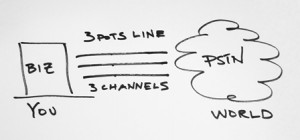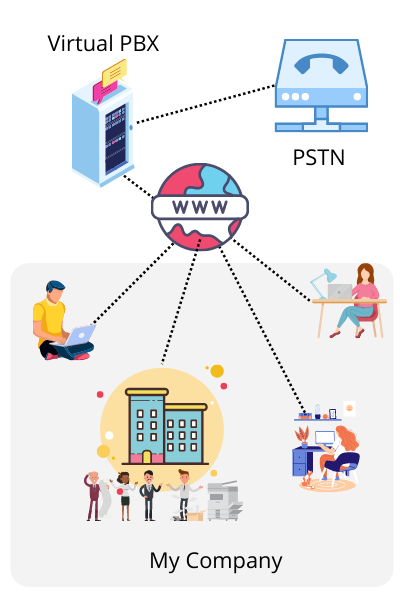
Business Phone Systems 101
How do business phone systems work? This is a very high level introduction to business phone systems aimed at conveying the right message to business
A virtual PBX allows employees to connect to the phone system using any internet connection device. This means that users can access the phone system from anywhere in the world.

Traditionally, PBX business phone systems are much more flexible than proprietary ones, using open standards and interfaces. Modern PBX phone systems use standard hardware, which is less expensive and can easily replace closed systems.
Using the Internet to deliver enterprise-grade services, companies can take advantage of some of the key benefits:
On average, business phone lines can range anywhere from $45-$80 per month based on minutes used and long-distance calling areas.
Many companies use 3rd party support consultants to support their PBX and pay extra fees. Hosted PBX phones are easy to use and be programmed by existing staff.
Hardware-based PBX (traditional or hybrid) systems can cost anywhere from $5000 to $20,000+ to install, wire, and program.
Whether you’re a large multi-site corporation, or a virtual company comprised solely of telecommuters, a hosted PBX can give instant communications between offices and employees at no cost.
Because all the main menus, voicemail, and extensions reside outside your office, even if you lose power or your Internet connection, your external callers will still get your main phone menu – every time.
A standard feature with a business phone system has multiple IVR Menus. Easily direct callers to the correct departments and end-users within seconds of their inbound call starting.
There comes a time when you are growing your business when you come to a specific problem or crossroads. Whether it involves hiring staff, looking for a new office or maybe putting aside a budget for next quarter’s digital marketing spend.
Whatever the case, I like to call these “good problems” in business. When your business is growing, you will most certainly be faced with new challenges and obstacles that you have never encountered in the past.
From my experience, company milestones and triggers are perfect scenarios when switching to a virtual PBX makes ideal sense.
Running your business from your mobile phone, what is your company’s main line? I am guessing it is the same as your mobile number. Are you marketing that number on your website and other marketing material?
The time will come when you will be too busy to handle every phone inquiry your company receives and will eventually want to grow your team by hiring your first few employees. But what will you do? Will you call forward all your calls to their mobile device? Furthermore, will you expect them to give out their personal phone number to all your customers and suppliers?
You may want to start looking and sounding like a larger one by at least getting the main business line and perhaps a toll-free number. But rather than going to the traditional “ma-bell “carriers, you should look at the virtual PBX providers who can also give a digital receptionist that plays a custom greeting when someone calls your number.
A great time to look at a new phone system is when it is time to look for a new office because your current office is too small. This is a fun scenario! Who doesn’t love shopping for a new home?
When moving and relocating, there are many things that you need to think of other than the phone system.
Yay, congratulations! You have a finely tuned business, and growth is a matter of expanding your presence by opening offices in different business centers and cities.
With a cloud-based virtual PBX phone solution, you can grow, share infrastructure, and manage the solution and service from any site.
When your business is humming like a fine-tuned engine, you have marketing feeding sales, orders being fulfilled, and employees being happy. At this time, you’re CFO is looking for creative ways to make money by saving money. He may turn to his CTO and ask her to look at existing infrastructure costs, and they both realize their monthly bills are outrageous.
Last but not least is the business continuity plan (DCP) and disaster recovery scenario. At this point, you are thinking of the lost revenue when things are not going so great. It may make sense to switch today by putting together this plan and analyzing the cost of moving to a virtual PBX versus the lost revenue of a telecom outage for X days.
If you found this article valuable, please share it with your colleagues so that can gain the same insight and move closer to a decision. Thanks in advance!
Want to learn more about Virtual PBX Systems? Here are some related articles that you may find useful:

How do business phone systems work? This is a very high level introduction to business phone systems aimed at conveying the right message to business

It’s happening! You’ve been thinking about it for a while now and have finally decided to switch to business VoIP. Good news, you are not

There comes a time when you are growing your business when you come to a specific problem or crossroads. Whether it involves hiring staff, looking


We’ll give you an intro to the perfect solution that fits your business. Get started on your journey to fearless growth.